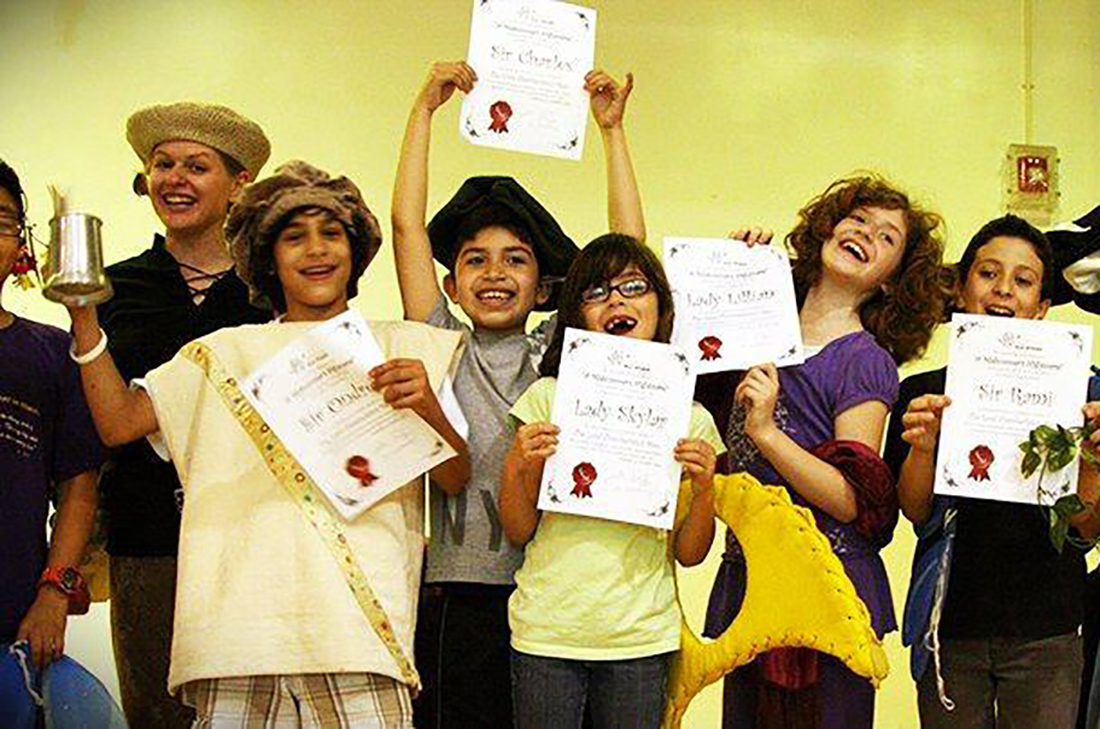By Jessica Gable
Ever since Arin Mulvaney first performed Shakespeare with a high school troupe for elementary and middle school students, her dream has been to bring her beloved Bard and his work to younger children.
Today, she is the Artistic Director of Shakespeare All-Stars, a group of professional actors who travel around Chicago schools to present Shakespearean plays or scenes to a captive audience of students. They give about 15-18 performances a year.
“A lot of kids don’t have any experience with Shakespeare before high school,” Mulvaney said. “So for some people, especially elementary schoolers, they’ve never heard of this guy Shakespeare.”
But it doesn’t take long for them to catch on. When Mulvaney’s actors begin the balcony scene from Romeo and Juliet, she frequently notices some people following along or mouthing the words made familiar if not by the play itself, then by pop culture’s spin on it. The biggest challenge for the All-Stars is not a lack of understanding on the children’s part. In fact, Mulvaney is usually impressed by their quick grasp of the archaic language and form of Shakespeare’s verse. No, the challenge is getting a foothold in a school system increasingly strapped for cash, especially when it comes to the arts. Most of their performances are done for private or suburban schools.

“When I envisioned the program, I was thinking of Chicago public schools, underserved communities, people who really need this,” Mulvaney said. “Some of those schools don’t have the resources. It’s not quite as easy to get into those schools.”
Mulvaney can’t always find a willing go-between at public schools in Chicago. Sometimes there’s no one for her to talk to at all.
Peter Garino, the artistic director of the Shakespeare Project of Chicago, presents Shakespeare readings done by Equity actors both for the public and for schools via the organization’s Education Outreach Program. They produce 50-minute versions of Hamlet and Romeo and Juliet, with fewer than five actors per show play all the characters. Each production costs about $400. According to Garino’s estimates, about 90 percent of their performances, like those of the Shakespeare All-Stars, end up being given to private schools that have more resources than public ones.

“There are some people who are like, ‘Are you absolutely crazy? There’s no way in the world we could ever come up with that,’” Garino said. “It’s disappointing that the public schools don’t have the same coordination and resources available. We see that ourselves. We recognize that it’s not our failing or our shortcoming. That’s just reality.”
Student response to performances by both organizations is usually overwhelmingly positive. Kids devour the action of a wrestling match in As You Like It, giggle at the wild antics of A Midsummer Night’s Dream and relish the romance of the balcony scene from Romeo and Juliet. But things are becoming more difficult as Shakespeare is taking a back seat in many classrooms in Chicago.

“There are schools in Chicago that have said, ‘it’s optional. You don’t have to teach Shakespeare anymore. You can teach The Life of Pi instead,’” Garino said. “So, this is really concerning to us.”
As of deadline, CPS had not responded to a request for comment.
But according to Mulvaney, reaching out to Chicago’s public schools has become easier since 2012. Chicago Public Schools have named more arts liaisons as part of its Creative Schools Initiative. Arts liaisons are school employees who coordinate and track improvements in arts instruction at their schools. But it’s still a struggle to find schools with adequate funding to support the performances of the Shakespeare Project or the All-Stars.
“I love Shakespeare and I want to share him with everyone I meet,” Mulvaney said. “So I hope we can expand it to more public schools in the future.”

